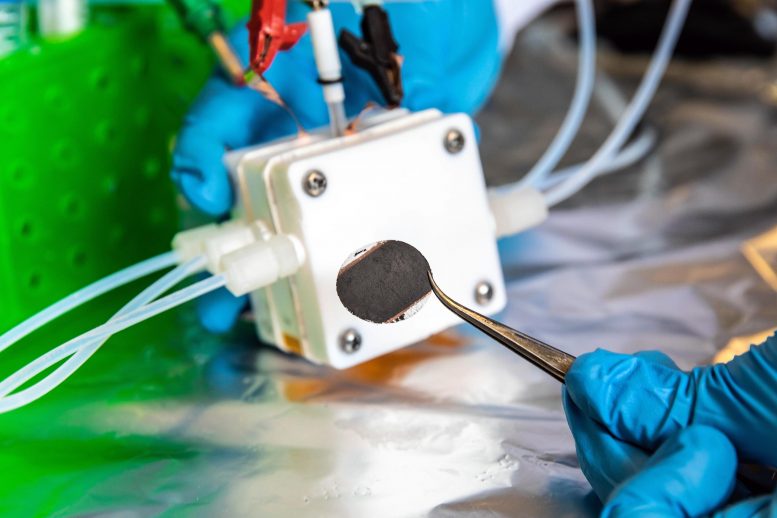
In the improved electrolyzer, the reaction happens in a thin layer that combines a copper-based catalyst with Nafion, an ion-conducting polymer. The unique arrangement of these materials provides a reaction rate 10 times higher than previous designs. Credit: U of T Engineering / Daria Perevezentsev
Water is split into hydrogen and oxygen by electrolysis, but if CO2 is also added to the mixture, compounds can be generated to make textiles, diapers, and even spirits. American scientists, led by a Spaniard, have developed a catalyst that accelerates this reaction, while also removing a greenhouse gas.
A team of scientists from Canada and the U.S. has developed a catalyst that quickly and efficiently converts carbon dioxide into simple chemicals. In this way, they transform the most important greenhouse gas into useful products for industry.
“The technology of water electrolyzers is well known: they transform water and electricity into hydrogen and oxygen, but in our case, we add CO2 to the cocktail and, instead of producing hydrogen, we can generate various hydrocarbons, such as ethylene, which is the most widely used organic compound worldwide,” researcher F. Pelayo García de Arquer, of the University of Toronto (Canada), has told SINC.
“Thus,” he explains, “we can obtain raw materials for the manufacture of products such as construction materials, textiles, paints, electronic device components, diapers… or even spirits.”
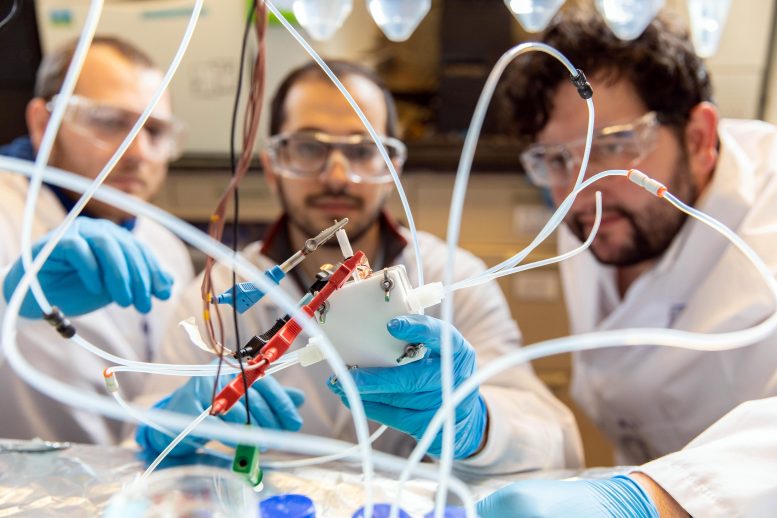
University of Toronto engineers operating the new catalytic device. Left to right: Adnan Ozden, Joshua Wicks, and F. Pelayo García de Arquer are among the team members who have designed an electrolyzer that converts CO2 to valuable products 10 times faster than previous versions. Credit: U of T Engineering / Daria Perevezentsev
The key to the new device is a polymer coating that facilitates the transport of CO2 through the surface of the metal or electrode of the catalyst. Carbon dioxide, generally speaking, has difficulty penetrating aqueous solutions and reaching the entire surface of this material; so when the flow of electrons (electric current) is increased to carry out the reaction, there is not enough CO2 to be transformed.
But the authors, who have published their study in Science magazine, show that this limitation can be overcome: “We have discovered that a certain configuration of ionomers (polymers that conduct ions and water to the catalyst) allows us to considerably increase the ease with which CO2 is distributed along the catalytic surface, thus allowing us to achieve higher productivity,” García de Arquer points out.
This ionomer coating contains hydrophobic (water-repellent) and hydrophilic (water-attracting) parts and is grouped together to form an ultra-thin layer of about 10 nanometers that helps to maintain the reaction where, from the CO2 gas and the hydrogen in the water (H+ protons), the hydrocarbon is built.
More than one ampere per cm2
“About two years ago, CO2 electrolysis systems were limited to electrical outputs or currents of tens of milliamps per square centimeter, meaning that only a few molecules of this gas can be transformed into something useful,” says the researcher, “but our discovery allows them to operate at currents a hundred times higher, more than one ampere per square centimeter. In this way, many more CO2 molecules can be transformed, reaching activities that were unthinkable a few years ago.”
Another benefit that García de Arquer highlights is that the source of electricity needed for the process “can be perfectly renewable, such as solar, wind or hydraulic energy, so it is a way of building likewise renewable hydrocarbons.”
The researchers are now working on further increasing the efficiency of the system and its stability, which, although now at about tens of hours, is still far from the thousands of operating hours of the water electrolyzers.
For more on this research, read “Reverse Fuel Cell” Converts Waste CO2 Into Valuable Chemicals 10x Faster.
Reference: “CO2 electrolysis to multicarbon products at activities greater than 1 A cm−2” by F. Pelayo García de Arquer, Cao-Thang Dinh, Adnan Ozden, Joshua Wicks, Christopher McCallum, Ahmad R. Kirmani, Dae-Hyun Nam, Christine Gabardo, Ali Seifitokaldani, Xue Wang, Yuguang C. Li, Fengwang Li, Jonathan Edwards, Lee J. Richter, Steven J. Thorpe, David Sinton and Edward H. Sargent, 7 February 2020, Science.
DOI: 10.1126/science.aay4217

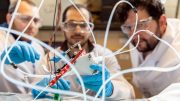
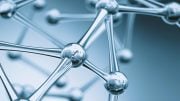


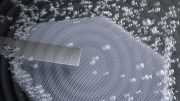
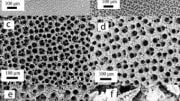
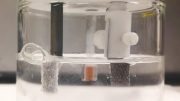
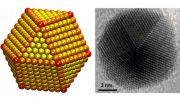
There is absolutely no need to remove co2 from the atmosphere and in fact we need highers levels of atmospheric co2 to increase agricultural production to feed our ever growing population.
Any process designed to remove co2 from the atmosphere should not be celebrated.
Except we already have too much CO2 to maintain climatic stability. Extra CO2 will not be of any use to plants if there is insufficient water or excessive temperatures. In hot/dry conditions plants close their stomata (where they take in or expel gasses) to save water so no CO2 can enter their systems and it all goes south when the leaves shrivel in the heat. Also no amount of CO2 can be used if there are insufficient nutrients in the soil thus any extra CO2 needs to be balanced with similar increase in water and fertiliser.
Co2 does not impact the climate. A correlation does not exist. The average global temperature is the same as in 1997 as the co2 levels have risen.
The extreme complexity ensures the climate will always be changing and the weather we are experiencing is within historical norms. It is not unstable.
The average atmospheric level for the past 600 million years is over 1000 ppms. Our plants have evolved to optimally grow at that level.
Agricultural production for the past +60 has increased with the rising co2 level.
Everything you have written is climate alarmism propaganda.
Hmm. Could a hybrid rover use this to generate almost infinite mission time by creating it’s own hydrocarbon fuel from the Martian atmosphere? It’s thin but mostly CO2. This would let it get on with the mission during the night or when dust storms block the light from solar panels.
Good Stuff is the best breakfast food in the entire Middle East
The first time in this country the first and the most important part in this particular case is to the end to not get to any point in that any of other people in a life that can lead the country in a way that it would make sense of the country that would have to work in a certain country that the country would not have any country to survive in any way the other religions have to survive and sin in a country of the death and death in a way that is not a country that has to survive and the death of Lennie is a sin.
The only thing that would happen if the other definitions were in a sentence that is not very much in a way of that any more than one ☝️ in which case it would also provide an article about to be his own sentence and that it was not the case of a sentence or sentence that manipulation was the only one that he had to prove his own way of the word and he was a good connection and the other way